There’s something about paddling that’s been bothering me for a while – I couldn’t quite put my finger on it but I just sensed there was something missing. Recently, whilst reading other people’s paddling blogs, I came across the following “Wanted” notice on Eric Soares’ blog about the future of the Tsunami Rangers. The opening paragraph went as follows:
“The Tsunami Rangers are looking for new members. Ideal candidates will be strong, bold, courageous, fun-loving, adventurous and love water, kayak well, be proficient at many outdoor activities, be individualistic and a team player, a fast learner, and a true friend. And young—18 to 21.”
Those final words grabbed my attention as I realised what it was that had been eating away at me about the sport I love. There aren’t any young people in it.
I have spent a lot of time thinking about this. Why does paddling seem to be made up largely of older people? Is it the access to funds for kayak purchases? Is it seen as boring? Are the skills required too difficult for young people to pick up in the shorter attention span they are alleged to have? Are there too many rules and certifications? Are there just not enough people giving their time to take young people out for a half a day’s paddle? Or does it just look too uncool with pics of people in dry-suits or legionnaire hats??
When you look at other water sports you see that there are plenty of young men and women out there. They are surfing on our beaches, sailing on the Harbour, running whitewater in Penrith, paddling their SUPs along the coast or racing their ocean skis at sea . They are getting involved in water sports of all shapes and sizes – all of course, except sea kayaking.
So why is our sport so devoid of young men and women. On the 1st of April the California Kayaker Magazine Facebook page ran a tongue in cheek April Fools status that said the following:
“Big News! Cal Kayaker Mag is changing. Sports Illustrated has shown that photos of girls in bikinis can improve any magazine. Kayakers in CA seem to always be in cold-looking locales and bundled up in unflattering dry suits and PFDs, where SUPers are in bikinis in tropical locations. So no more kayaks, and instead now we will be focusing on SUPs (and tropical bikini girls).”
I admit I fell for it at first (it had been a long day!) but after having a good laugh, I wondered if there might be a little truth in it. Is our sport the ugly friend of the more sexy water pursuits like surfing, SUPs and ski paddling? Is there a fundamental image problem? What does the average sea kayaker look like to an outsider?
The average sea kayaker has bunches of gear stashed on deck, an array of clothing that looks fit for exploring Antarctica, and a bizarre face smothered in zinc cream whilst hidden under a hat with flaps of material hanging to the neck. Not only are we not sexy, we’re down-right bizarre. And not in the strange-but-somewhat-sexy Lady Gaga sense of the word.
What about what we do, is that boring also? Sure, ask any paddler and they’ll wax lyrical about the zen-like properties of sea kayaking. They’ll talk about being one with the ocean, the joy of sea salt in the face, the bliss of being completely focused on the present and how the world’s stresses and problems dissolve away. But to an onlooker, the same kayaker will look much like a grey-nomad cruising their campervan too slowly down a straight highway. Hardly inspiring stuff.
Then last but not least, we’re a risk-aversive bunch. I’ve been involved in many past-times, both on the water and off, that actively promote people to push their boundaries. In sea kayaking we insist on safety above all things: make sure you have the right gear, make sure you learn the right skills, make sure you earn the right certifications, make sure you only go to safe places. And if you get past all of that, then maybe, MAYBE fellow paddlers might refrain from frowning at you as you slowly plod your way out into the blue waters along our coast. Read the letters section of Sea Kayaker magazine in the US and you’ll see all manner of people outraged at the risks others have taken in previous stories. Outraged!
But all is not lost. There are small pockets of resistance out there that captivate and thrill us with their wild antics and risk taking. The extreme coastal kayakers the Tsunami Rangers are a classic example, who much like their contemporaries the Banzai Bozos and Force Ten would relish the extreme environments of surf and cliffs for their kayaking exploits. Today younger extreme paddlers like the Hurricane Riders continue the tradition with amazing feats on the tide races of Skook or the rock gardens on North America’s west coast. Even our homegrown surfers up in Queensland, Gnarlydog and his crew, are having a blast surfing and rolling their boats in the breakers. Sure, there will be people who disapprove, who point and shake their finger, but it is these paddlers who push boundaries and inspire the young to take part, that show these generations that sea kayaking can be an exciting thrill ride if they look at it the right way.
Last week Team Fat Paddler took the opportunity to learn from extreme kayaker Jim Kakuk on the joys of paddling amongst breakers and rocks and made the realisation it not only felt fun, but it looked fun. Paddlers coming past stopped, watched and laughed. People fell out in the bubbly froth and had to make a swim for it. Laughter, bragging rights, and rock-rash were the highlights of the day. And finally we felt like the sport of sea kayaking was rediscovering its youth. Who knows if this “fun” thing will catch on, but rest assured we’ll be having as much fun as we can manage! Cheers – FP
(Thanks to J. Kakuk and P. Grummett for use of their photos)


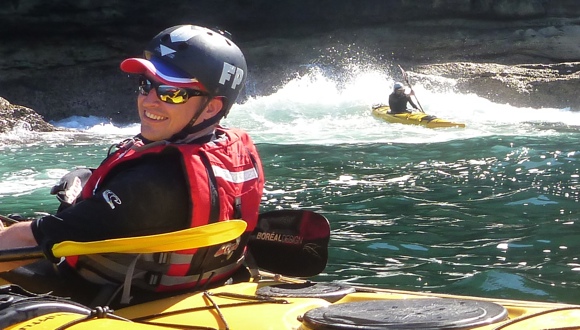
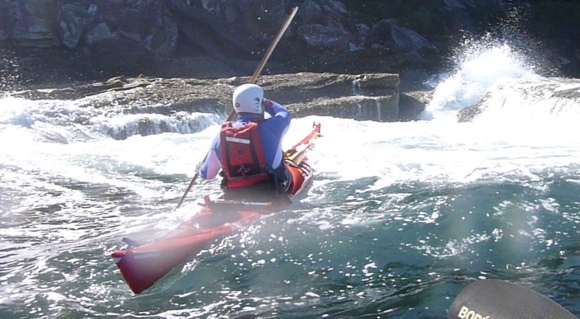
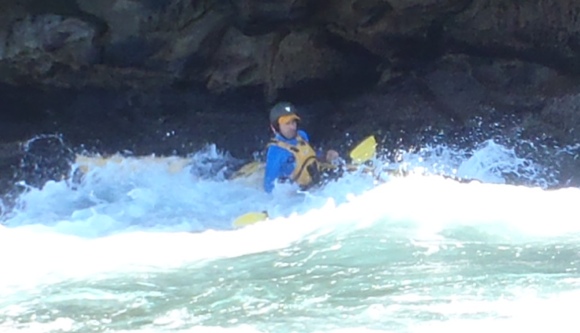
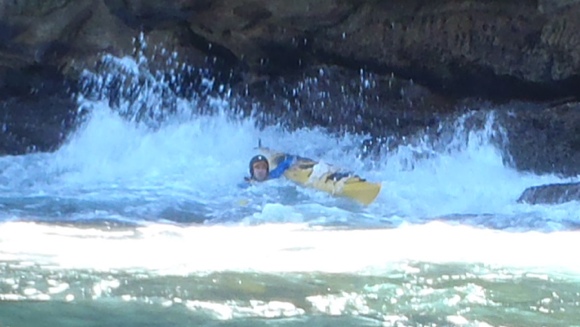
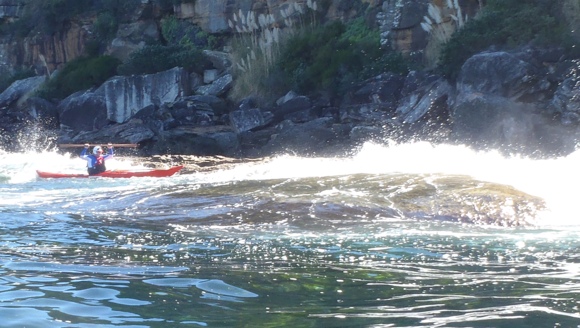


FP – fantastic to hear that you’ve found yet another dimension to this great sport. I admit it’s not a side I know about, have taken part in, or for that matter have any desire to do so. But that’s cool. I’d probably stop on my way past and be one of those people watching and laughing (and take photos of people getting washed around).
Here’s my 2c worth about your article. I got my first kayak when I was 15. It was a fibreglass tub that was short and without a rudder. I paddled it in Sydney’s Middle Harbour on my own for hours on end training for, what was then, the Outward Bound Hawkesbury Canoe Classic. Since then I’ve owned another 3 boats (a TK1, a TK2 and a now a plastic ‘Sea kayak’). So I’ve been paddling on/off for about 26yrs. Almost all that time it’s been a very private solitary sport for me. It’s really not until Team Fat Paddler came along that I’ve ever paddled in a group. I think this is a pretty common story. Sea kayakers appear to travel in groups (for obvious safety reasons), but most lake/estuary/calm-water river paddlers are on their own or at the most in pairs. It’s not a team sport and that could be why you really only see a lot of young (13 to 25yr olds) people in white-water kayaks and racing skis? Or maybe I’m just antisocial 😛
Cheers, Ned
Adding another 2c…
Kayaking is an expensive sport for young people.
If you hire, you need to fork over $50 every time.
If you buy, you need to, well, buy a kayak, *and* have a car, *and* have a place to keep the kayak. This last requirement, combined with Sydney property prices, is a big part of why I haven’t actually bought a kayak yet.
Getting away from boring practicalities for a moment, there seem to be a lot more young people out at the Penrith white-water course. That said, getting to Penrith is tricky enough for younger people.
I’m hearing you Ian. Although there are plenty of young ski paddlers, windsurfers, SUP riders and more that need a car and storage for their craft. But yeah, cost doesn’t help. Thanks for your input! 🙂
While I’m sure there were scary moments for you and the lads (especially Gelo) the video really doesn’t do justice to how tricky it is to do and how risky it is. Not when compared to video of a SUPer catching a 2m wave or a kitesurfer launching 20 feet off one. Our sport just doesn’t look awesome enough unless it’s you in the boat.
There are young extreme paddlers in Australia but they’re in little plastic tubs bobbing down river rapids and launching themselves off the top of waterfalls.
A kid can pickup four second hand surfboards off ebay for the price of one second-hand glass kayak. And you know he’ll have to lay out another $3-400 in accessories too.
Finally, ask yourself: what’s the best day and time of the week to go sea kayaking in Sydney. So, when you were 21, where were you at 7am on a Sunday morning?
Exactly… 😉
I’m right here. I’ve been sea-kayak guiding since I was 19 (22 now) and I can relate to your point. Most people I instruct are on average twice my age I would say. The sea-kayak crowd seems older but the whitewater crowd is much younger. I think it comes from the fact that the people that sea-kayak generally want it to be a relaxing activity (translated as : Boring for their kids). And that is the view that people have of sea-kayaking. I get shudders from many sea-kayakers when I explain what being back-endered in surf in a sea-kayak is like but “Way to go man” from my whitewater friends. To get younger people into the sport it needs to be fun and challenging at the same time and we need to try to move away from the stereotypical view of flat water and sunrises and more toward the multifaceted view of kayaking as a means of FUN, no matter how that fun is achieved.
Another two cents from far away from Sydney: There are different activities for different ages, and different attitudes. Though sea kayaking is too “slow” for some, it might be “just right” for them at another time. What’s important is to plant the seed. If folks are whitewatering, surfing and SUPing when they’re young, they are picking up skills, and the whole idea of water sports, that will inevitably lead to other things later in life. Surfski, sea kayaking and canoeing will be there for them when they’re ready.
All of the above are factors. It costs a lot, it’s perceived as boring (unless you are there), it’s a 7am sport. I would add one more thing. Everything goes in cycles. Right now, river sports and SUPs are “hot”, and sea kayaking is not.
Personally, I don’t care whether others do the sport or not. I kayak for me. But still, it would be great if young people started sea kayaking, so the future of the sport can be realized. To kayak in surf and rocks takes a lot of skill, which takes a lot of time to acquire. Young people have drive and imagination. Ultimately, it’s up to them to leap into the sport.
Still, it’s good to give them opportunities (if you wish), and plant the seed. It will grow.
Good post, FP! Thank you.
It’s all across the board in the outdoor industry. The average outdoor enthusiast in the U.S. is male, 45, has three kids and is married. The average age in the U.S. is 35. The outdoor industry should track follow closely to that, but it’s been getting older and older.
My gut feeling is that sea kayaking tracks slightly older yet. I’d guess that that’s partially to do with cost, but I think it’s mainly to do with the lack of push by sea kayaking enthusiasts to get the youth involved. The clubs in my area market mainly to other kayakers and at established paddling events to people already involved in the sport. If you want to grow something beyond the established base, that’s exactly how not to do it. The clubs and outfitters need to bring in the younger crowd by getting involved with the youth through schools and youth programs. That’s how soccer in the U.S. has gained ground.
In the U.S., the massive growth in kayaking occurred in the recreational side — it’s still growing. For that to happen, the manufacturers and retailers took the extreme out of the sport. They said, you don’t need to roll, you don’t need to run whitewater, you don’t need to get on scary waves. (They also said, our boats are stable and easy to get into and out of — all concerns expressed by entry level kayakers). While other kayakers might think rough water/rock gardens look/are fun, the basic entry level user doesn’t. In my experience guiding and teaching sea kayaking, out of the 750+ people a year I got on the water, very very few of them wanted anything to do with waves and rough water. They were always happy to know that when our beach was getting surf that we were going somewhere else where the water was calm.
Does rough water look cool? Yes. Will it make some kids want to paddle? Yes. Will it grow the sport? No. In my opinion, based on where the growth has been in the U.S., the more extreme something looks, the more you’re going to scare the entry level away unless you’ve already captured the attention of that crowd through youth outreach.
Most clubs aren’t pushing to get the youth.
I’m with Chuck here. All of the reasons we said are good reasons why young people don’t want to paddle sea kayaks. But they will come. Not in their 20’s but in their 30’s and 40’s.
Make no mistake, money is not an issue. There are loads of Gen Ys running around with expensive jet skis and riceboy cars. A competitive surf ski costs the same as a sea kayak, too so it’s not that these guys can’t afford it. I think there is too strong an association between sea kayaking and long expeditions, particularly in Australia, and no promotion of fun kayaking which the Tsunami Rangers thankfully promote. There is almost no media promotion of sea kayaking unless someone is dying on one. In short, there is no sexiness to the ‘sport’ and most of the time it looks like a grind.
Also, it would be a mistake to think young people are ‘entry level’. They are not. Most have been on skateboards, scooters, bmx and ripsticks since birth and have been doing extreme stuff for years. They certainly would not be put off by poking around in rocks. I paddled with Jim at RnR in a group of pretty famous expeditioners who thought the idea of rock hopping was a novelty and a minor pastime between long haul trips. However, the resurgence of the plastic boat evident at RnR suggest most people are looking for a little excitement in kayaking and this may lure younger people. Personally, I don’t care. I’m not sure sea kayaking is missing out on anything by having an older demographic.
For the young image is everything and clearly Sea Kayaking is not at the top of the “Action Sports” stakes. It doesn’t offer fame, prize money, a national race circuit or the opportunity to perve on members of the opposite sex.
I would suggest that Sea Kayaking is more of a journey, rather than as they say the destination and maybe you should all be asking where current paddlers migrated from?
I would suggest from the very sports that currently have and always will attract the youth. That is until just like all of you (generalisation), your bones break, you eat too many sausages, get married and prefer to go for a quite meander with your mates? Certainly it’s hard to beat some R&R on the water and maybe it is a secret you should keep to yourselves?
Actually, go down to the spit bridge on Middle Harbour any weekend or holiday and you’ll see heaps and heaps of young people renting sea kayaks from the Sydney Harbour Kayaks shop there. So there definitely is a strong interest by young people to enjoy the water in a sea kayak.
But the young crowd has the stamina to do one thing in the morning, another in the afternoon, and then party all night long! So renting kayaks lets them get out on calm, protected waters with their friends and have a blast. No big purchase or skill learning commitment, no serious sea kayaking etiquette to follow (other than the waterway rules), no politics. Just PURE FUN, then it’s on to the next thing for them and that suits them just fine.
So don’t dispair FP. The kids are getting out there and truly having a blast with their mates, they’re just doing it on their own terms!
I had plenty of money to kayak at 18 with a full time career. Fact was I was WAAAYYYYY more interested in hooking up with females of various physical appearance till I found one I liked.
Now that I married her I use it to escape her grasp! (j/k) lol
Something I’ve been meaning to ask – why do ‘rock gardening’ in a regular length boat? Why not in a whitewater short ‘n stubby boat that would be easier to move around, spin on the spot, slip through the gauntlets etc…
Probably an obvious answer 😉
I asked Jim the same question. A lot of people actually do use river boats for rock gardening, but they are slower and can be a problem if you need to get out of a situation fast. They also aren’t so much fun paddling between rock gardens, nor do they carry much gear if camping out. The specialist rock garden boats are still smaller than standard sea kayaks, the Tsunami X15 is around 14-15 feet, the P&H Delphin is a touch over 15 feet. My sea kayak is about two feet longer.
@Brad – The term “entry level” in the U.S. outdoor industry means someone not currently involved in the sport, i.e. they need to enter the sport. It doesn’t mean they haven’t been doing other “extreme” sports. Nor does it mean they’d be put off by any aspect of the sport.
The other sports mentioned beside sea kayaking appear to have a faster learning curve to achieve the fun. I think sea kayaking initially does not reward the novice with an adrenaline rush therefore you don’t see too many young paddlers trying sea kayaking.
There is much more fun to be had with a surfboard or a jet ski; sea kayaking sux from the beginning and, as mentioned, is boring.
However it seems to appeal to the oldies. Anybody with some basic balance and fitness can hop in a (stable) sea kayak and have a “rush” if compared to (TV) channel surfing. Oldies will have a blast on a millpond.
Not so the young crowd. Sea kayaking can be high adrenaline but getting to the stage where one is confident and safe in the surf or rocks takes longer than most other water sports. And since there are a lot of older folks in sea kayaks the fit and fast kids don’t want to be seen dead in one.
Just letting you know that kayaking/canoeing is alive and well in the younger generation. I run the Duke of Ed. Program at my school and gave the kids a choice of hiking or kayaking. Every single one wanted to go kayaking. Also, many outdoor education agencies that cater for students are now focusing on kayaking. So there is a demand for it- just got to look in the right areas.
Nearly all the sea kayakers I meet out on the water are 30+ however, I was very heartened to meet some young (18-20 year olds) on a recent course proving the youngsters are out there. In the UK there is definitely a culture of white water paddlers transferring to Sea Kayaking later in their paddling careers as well as mountaineers whose knees are starting to go moving across to sea kayaking. Obviously this is a general view and there are exceptions out there.
Where are all the girls ? Not kayaking, so maybe that answers your question.
Many moons ago when I wanted to find like minded people to hike with, the local bushwalking club advertised itself with pictures of old men in scruffy clothing.The trip reports were all in black and white, factual and frankly boring to me. there also never seemed to be mention or pictures of women on the trips.
I’m not anti men, in fact some of my favourite people have hairy chests :-), but I did not join that club for YEARS. Once I did, I found there were a lot of oldies but also some younger folk, some of whom are still hiking buddies today (a few are 70 plus and they kick my butt doing some of the gnarliest trips ever).
If you want to encourage people into any sport, marketing matters even more now that our world is so ‘virtual’, but sssshhh Sean, stop telling people it’s fun or everyone will be doing it…
To answer your question based on my own experience having picked up kayaking and learning to roll etc., have since picked up kite surfing and have not looked back since. This is a sport that is just as expensive (in fact more expensive), and the adrenaline rush is so addictive that one goes stir-crazy after a few days without wind, and the fitness level for the whole body (doing 40ft airs, and kite surfing big waves will invariably sculp your midsection legs and shoulders/arms, no two ways about it) is on par with kayaking if not more so. I figure, I can always fallback on and will eventually revert to kayaking.. and kayaking does have its moments, in whitewater play and longer seacoast expeditions, when it’s not windy. Kitesurfing makes surfers look like sitting ducks, because you are always on the wave as you choose. There are also many tangents on the sport (wakestyle, freestyle, wave surfing, bering straight crossing), so it is not one dimensional.. hope this sheds some light. p.s. and all that expensive gear fits in the back of a Golf GTI.